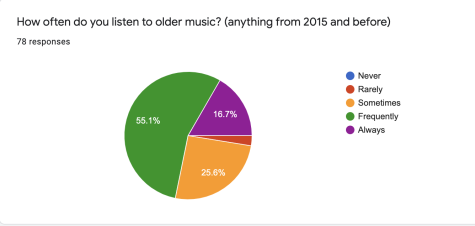The Growing Divide Between New Music and Old Music
Recently, old songs, songs from the past – 2015, now represent over half of the U.S music industry. With the consumption for older songs increasing, current and upcoming artists face a new challenge: The market for new-music is actually shrinking.
March 19, 2022
Old songs now represent 70% of the U.S music market, according to the latest numbers from MRC Data, a music-analysis firm. With albums such as Thriller by Michael Jackson and Abbey Road by The Beatles, it is clear that old music never lost its relevance.rather, the demand for new music is decreasing. Nielsen, a data and market measurement firm, states that “since the beginning of the year, songs from Mr. Jackson’s solo catalog have been streamed 16 million to 17 million times each week in the United States.” As such, the music industry has become an industry dominated by classics. Albums that have stood the test of time remain relevant in the market as people can always rely on them for a pleasurable, listening experience.
Newer music, however, doesn’t have the seal of approval that many older songs do. While older songs have had the time for others to digest the material, newer music is exactly that: new. Without any reference to how the music has aged over time, aside from a few exceptions, new music falls into two main categories for the consumerCommonly, new music gets completely disregarded from the overpopulation of other songs, or gets listened to frequently for the duration of a month and then is forgotten. The lack of longevity has been a killer to new music and has provided more evidence to the fact that time is what brings success in the music industry.
The shift in culture can also be a reason as to why older music is performing better than newer music. While albums like After Hours (2020) by the Weeknd and 2021’s, Call Me If You Get Lost, by Tyler The Creator certainly exist, to name a few, a majority of recent EP ’s (Extended Play) and LP’s (Long Play) have not implemented a cohesive vision throughout each track. Instead, albums have been mashed together to create as many hits as possible. Quantity over quality has become a recurring theme as it displays the downward trend that new music displays.
With many stream based goals for newer artists, albums have become overstuffed with too much content. With the increase in tracks, the consistency in quality has been an issue. Alongside the overblown records, short singles have started to dominate the market because they provide the easiest way to reach high streams. With the change in goals from older artists to newer ones, the relative quality of music has diminished as well.
75 BCA students were polled to see if the trend of old music was also true of our own demographic. A majority (54.7%) stated that they listened to older music frequently and 17.3% of the students stated that they always listened to older music. A quarter of the students reported that they listened to older music sometimes, with only two students citing that they rarely listened to older music. No votes were submitted for never listening to old music. 
When asked to choose between older and newer music, 20.5% of the students stated that they listened to newer music more, 24.7% of students stated that they listened to older music more, and 54.8% of students stated that they listened to both. Given that the BCA student body is composed of a younger demographic, the fact that older music has a greater presence proves that newer music is falling behind.







